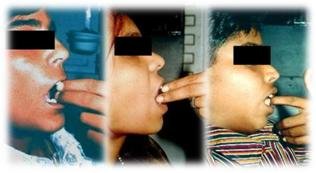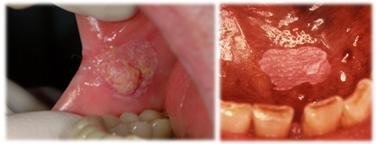Quit Smokeless Tobacco
Chewing tobacco affects your dental health as well as the rest of your body.  Chewing tobacco includes snuff, a finely ground version of processed tobacco, and chewing tobacco in the form of shredded or pressed bricks and cakes, called plugs, or rope-like strands called twists. Users "pinch" or "dip" tobacco and place a wad in their cheek or between their lower lip and gums. In India it comes with 'katha' -lime.
Chewing tobacco includes snuff, a finely ground version of processed tobacco, and chewing tobacco in the form of shredded or pressed bricks and cakes, called plugs, or rope-like strands called twists. Users "pinch" or "dip" tobacco and place a wad in their cheek or between their lower lip and gums. In India it comes with 'katha' -lime.
Isn't it safer than smoking?  Absolutely not. Some wrongly believe that chewing tobacco is safer than smoking cigarettes. But chewing tobacco is more addictive because it contains higher levels of addictive nicotine than cigarettes and can be harder to quit than cigarettes. One can of snuff deliver’s as much nicotine as 60 cigarettes. About 8,000 people die every year from tobacco use.
Absolutely not. Some wrongly believe that chewing tobacco is safer than smoking cigarettes. But chewing tobacco is more addictive because it contains higher levels of addictive nicotine than cigarettes and can be harder to quit than cigarettes. One can of snuff deliver’s as much nicotine as 60 cigarettes. About 8,000 people die every year from tobacco use.
About 70 percent of those deaths are from oral cancer. Other cancers caused by tobacco include cancer of the pancreas, nasal cavity, urinary tract, oesophagus, pharynx, larynx, intestines and the stomach. 
Kids who use spit tobacco products are 4 to 6 times more likely to develop oral cancer than non-users and tobacco juice-related cancers can form within five year of regular use. Among high school seniors who have ever used chewing tobacco, almost three- fourths began by the Standard eight.
Effect on Dental Health
It causes bad breath, discolours teeth and promotes tooth decay that leads to tooth loss. Chewing tobacco users have a decreased sense of smell and taste, and they are at greater risk of developing cavities. The grit in snuff eats away at gums, exposing tooth roots which are sensitive to hot and cold temperatures and can be painful. Sugar in chewing tobacco causes decay. Chewing tobacco users also have a hard time getting their teeth clean.
Oral-effects of chewing Tobacco
Mouth Sores  The most common sign of possible cancer in smokeless tobacco users is leukoplakia, a white scaly patch or lesion inside the mouth or lips, common among many chewing tobacco users. Red sores are also a warning sign of cancer. Often, signs of precancerous lesions are undetectable.
The most common sign of possible cancer in smokeless tobacco users is leukoplakia, a white scaly patch or lesion inside the mouth or lips, common among many chewing tobacco users. Red sores are also a warning sign of cancer. Often, signs of precancerous lesions are undetectable.  Dentists can diagnose and treat such cases before the condition develops into oral cancer. If a white or red sore appears and doesn't heal, see your dentist immediately for a test to see if it's precancerous. Chewing tobacco users also should see their dentist every three months, to make sure a problem doesn't develop. Studies have found that 60 to 78 percent of chewing tobacco users has oral lesions.
Dentists can diagnose and treat such cases before the condition develops into oral cancer. If a white or red sore appears and doesn't heal, see your dentist immediately for a test to see if it's precancerous. Chewing tobacco users also should see their dentist every three months, to make sure a problem doesn't develop. Studies have found that 60 to 78 percent of chewing tobacco users has oral lesions.  Those who mix snuff and chewing tobacco, are more likely to develop precancerous lesions than those who use only one type of chewing tobacco. Long-term snuff users have a 50 percent greater risk of developing oral cancer than non-users, and chewing tobacco users are more likely to become cigarette smokers.
Those who mix snuff and chewing tobacco, are more likely to develop precancerous lesions than those who use only one type of chewing tobacco. Long-term snuff users have a 50 percent greater risk of developing oral cancer than non-users, and chewing tobacco users are more likely to become cigarette smokers.
Quit Smokeless Tobacco Today We should start by asking you this one question: If you knew there was over 3,000 harmful chemical compounds in your favourite cup of coffee in the morning, would you still drink a half a pot a day? Probably Not! So, the next question would be: Then why would you decide to put chewing tobacco in your mouth?
We should start by asking you this one question: If you knew there was over 3,000 harmful chemical compounds in your favourite cup of coffee in the morning, would you still drink a half a pot a day? Probably Not! So, the next question would be: Then why would you decide to put chewing tobacco in your mouth?
There are over 3,000 different chemical compounds in smokeless tobacco, and 28 cancer-causing agents - and that is in every single dip you put in your mouth!
That alone should be enough reason to quit, don't you think? Unfortunately, quitting is a lot easier said than done. In fact, the majority of people that try to break the nicotine habit fall back into habit relatively quickly - Unless They Have A Plan!
Have you been Thinking About Quitting Chewing Tobacco?
Make the following goals to quit and never resume chewing: 
Instead of using chewing tobacco, carry substitutes like gum, hard candy and sunflower seeds. 
Let friends and family know that you're quitting and solicit their support. If they too chew, ask them not to do it around you. 
Make a list of three situations you're most likely to chew, and make every effort to avoid using tobacco at those times.


